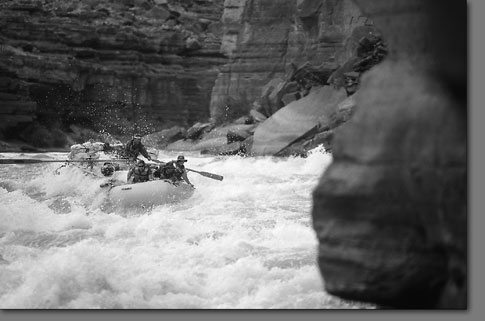| ||||
| Grand tilts more toward private boaters Plan scales down commercial trips on world's premier river SideStory: The end of the waitlist
by Will Sands Emotions are widely split over the Grand Canyon this week. The guidelines for running the world’s most famous stretch of river just got a substantial facelift, and some are hailing the National Park Service’s new rules as an admirable compromise. Others are calling them a “slap in the face” to a unique ecosystem. On Nov. 10, the National Park Service brought an end to nearly a decade of analysis and negotiation with the release of the final version of the Colorado River Management Plan. The document will guide public usage of more than 275 miles of the Colorado River through the Grand Canyon for at least the next 10 years. The new version represents a significant departure from the past 20 years, which were dominated by a heavy emphasis on commercial raft trips and private boaters waiting up to two decades for a three-week trip. Now, more people will be allowed to boat the Grand Canyon in a given year. However, the river will also be less crowded due to a wider distribution of launch dates, reduced number of boaters on each trip and fewer launches per day. The plan also calls for more private trips and fewer spaces for commercial river runners. Unlike the current split of 60 percent commercial to 30 percent private, the park service is calling for a nearly 50/50 split. As an added bonus to the private boater, the agency will authorize fewer motorized rafts and more human-powered ones. Congestion in the canyon will be alleviated by spreading trips throughout the year with more launches in the fall, winter and spring. The Grand Canyon’s notorious wait list will also come to an end in favor of a weighted lottery system (see sidebar). Hardest hit with the changes will be commercial operators, who will have to redraw their schedules and business strategies before the 2007 season, when the new rules take effect. In spite of the impacts, many raft outfitters are generally supportive of the changes and a more peaceful future in the Grand Canyon. “Our general reaction is that the plan is workable,” said Mark Grisham, director of the Grand Canyon River Outfitters Association. “We understand that the National Park Service has to balance a lot of competing interests.” Grisham added that the biggest impact to outfitters will be a 10 percent reduction in the number of motorized rafts and the resulting conversion of motor rigs to oar boats. “The park is trying to provide different opportunities for different users during different times of the year,” Grisham said. “They’ve created a stepped process, and getting there will require fewer motorized trips.” On the flip side, private boaters get a leg up with the new plan. Several groups, including the Grand Canyon Private Boaters Association, are praising the National Park Service for more equitable treatment of the private boater. “We got a significantly greater number of launches,” said Willie Odem, of the GCPBA. “Our user days are now nearly on par with commercial user days.”
“We got a significantly greater number of launches,” said Willie Odem, of the GCPBA. “Our user days are now nearly on par with commercial user days.” Like Grisham, Odem recognized the final solution as an artful compromise and the result of many years of often contentious negotiation. “We sat down with the commercial interests and said if we can’t come to an agreement, we’re going to be fighting for decades,” Odem said. “Private river runners and commercial operations are just two very different beasts. Without some changes, the Park Service would have been stuck brokering between two warring factions.” In spite of the compromise, the Park Service may still be in for some serious brokering. Many had called for a total end to motorized rafting in the Grand Canyon and a wilderness-style management of the river. Motorized commercial trips degrade both the environment and the private boaters’ experience, according to Kim Crumbo, of the Arizona Wilderness Coalition. “This is a slap in the face to the millions of people who cherish the Grand Canyon’s wild Colorado River,” she said. “Why should visitors bother escaping downtown Phoenix or New York City when they can find the din of motors and throngs of people right there in the heart of this wild canyon?” Crumbo said that the new plan continues to allow excessive numbers of people to make the trip through the Grand Canyon, continues to emphasize and permit motorized uses and is in direct conflict with National Park Service policy. “The Park Service should manage for a high-quality wilderness experience, not push the numbers as high as visitors can stand,” she said. “Their priorities are clearly not with visitors, but with the handful of motorized concessionaires who profit from the river.” Another advocacy group, River Runners for Wilderness, had also recommended gradually phasing out motorized trips through the canyon. “This plan, six years overdue, makes a sad mockery of wilderness character on America’s premier river trip,” noted Jo Johnson, of River Runners for Wilderness. Grand Canyon National Park Superintendent Joseph Alston counters these charges, saying his agency did its best to balance a wide range of users and input. “We believe our process has been open minded, transparent and fair,” he concluded. “We have spent the last several years listening to and responding to a wide range of comments from individuals, groups and organizations.” A complete copy of the final Grand Canyon Management Plan can be downloaded at www.nps.gov/grca/crmp. •
|



